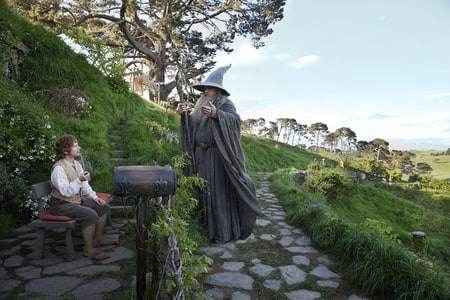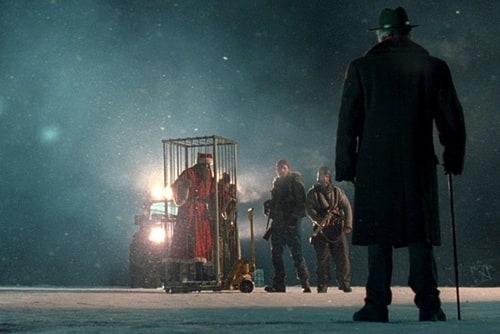Following up Peter Jackson's groundbreaking The Lord of the Rings trilogy with a film adaptation of The Hobbit was always going to be a tricky proposition. Whereas The Lord of the Rings is a dense, dark and mature fantasy epic, J.R.R. Tolkien's The Hobbit is a children's book with a light tone and a simplistic narrative. Hence, any fans of Jackson's trilogy expecting The Hobbit to be similarly gritty and expansive will be disappointed. Plus, you will need to accept the fact that The Hobbit was never going to be as good as LOTR - Jackson's Rings was a once-in-a-lifetime achievement that can never be equalled or topped in terms of sheer excellence, charm or emotional impact. If you can suitably adjust your expectations, however, 2012's The Hobbit: An Unexpected Journey is a solid return to Middle-earth; a damn good fantasy adventure that's funny, fun and visually succulent.

In the Lonely Mountains, the treasure-filled dwarf kingdom of Erebor is overtaken by the dragon Smaug, forcing the dwarves to abandon their home. Set 60 years before the events of The Lord of the Rings: The Fellowship of the Ring, An Unexpected Journey concerns humble Hobbit Bilbo Baggins (Martin Freeman), who's suddenly visited by the wizard Gandalf (Ian McKellen) and thirteen dwarves led by the great Thorin Oakenshield (Richard Armitage). The company is on a quest to reclaim Erebor, and are on the lookout for a small, stealthy thief to join the team. Although initially reluctant, Bilbo agrees to be the dwarves' burglar, leaving the comfort of his warm home as he sets out into the perilous world of Middle-earth. Thrust into the adventure, Bilbo encounters trolls and Orcs, as well as the cave of the creature Gollum where he finds the infamous One Ring…
Tolkien's Lord of the Rings novels ran for a total of 1500 pages and thus needed to be extensively truncated for the screen, but The Hobbit is a meagre 300 pages long, compelling Jackson and his co-writers (Fran Walsh, Philippa Boyens and original director Guillermo del Toro) to extend the slender kid's book to produce a prequel trilogy. Rather than simply padding everything out, the writers mined material from Tolkien's other works, further delving into certain characters and establishing additional connections to the LOTR universe. Cynical critics are destined to bash the trilogy notion as a cash-grab, and whine and moan that An Unexpected Journey feels too padded out, but the film actually works. It may be easy to call the film overlong but I cannot think of any scene or dialogue exchange that should be removed. Running at 160 minutes, the film has breathing room for proper character development and dramatic growth, two aspects of which are crucial in a story with so many protagonists. An Unexpected Journey is inherently tied to the events of The Fellowship of the Ring as well. The tale is framed around elderly Bilbo (Ian Holm) writing his memoirs while preparations for his 111th birthday party are well underway. To further the prequel angle, An Unexpected Journey is not solely concerned with the dwarves setting out to reclaim their home - there's a side story involving Gandalf investigating the possibility of Sauron's impending return.

Bilbo is initially anxious about leaving The Shire and he doesn't feel a sense of belonging with the dwarves, but he gradually develops into a man of courage and confidence, and his originally pessimistic companions grow to accept the Halfling as one of their own. This character arc gives the picture a degree of heart and emotion, two aspects which made The Lord of the Rings so excellent. Another tremendous benefit of An Unexpected Journey is the colourful and lively dialogue, not to mention the picture's wonderful sense of humour. The comedy does not feel cheap, however, but rather a natural extension of the dwarves' personalities as well as the nature of dwarves in general. The reintroduction of Gollum (Andy Serkis) is another huge plus. The return of this cult favourite comes at just the right time, and his game of riddles with Bilbo provides a delightful scene of character interaction that's every bit as exciting as the large-scale battles. Gollum looks astonishingly realistic here, highly detailed and with plenty of facial nuance courtesy of Serkis' expectedly brilliant motion capture performance that's incredibly entertaining to watch. Anyone who has read The Hobbit (this reviewer included) will be stoked with Jackson's cinematic treatment of some of the book's most iconic scenes.
Jackson started his career in low-budget cinema, forcing him to make the most of every dollar and focus on intensity rather than pure effects overload. The Hobbit: An Unexpected Journey is a CGI bonanza, yet the film is also genuinely exciting and at times nail-biting. The decade separating The Lord of the Rings and The Hobbit has yielded enormous technological advancements; Jackson's WETA Workshop have raised the bar yet again, providing some of the most vibrant and stunning digital effects glimpsed in a motion picture this year. A few creatures admittedly look a bit too glossy and digital, however, and one feels that the creatures should've been brought to life using the incredible make-up effects which made the Uruk-hai in LOTR so memorable. Still, it's often difficult to discern where the live-action halts and the CGI begins. Plus, location shooting plays a huge part in the production, with the expansive landscapes of New Zealand providing gorgeous vistas and with intricate set construction breathing amazing life into Tolkien's visions.

Due to the decision to shoot digitally, An Unexpected Journey carries a different cinematic look, though the colour timing is reminiscent of LOTR. Cinematographer Andrew Lesnie also shot The Hobbit in 3-D in 48 frames per second (as opposed to the traditional 24fps) to give the experience a hyper-realistic look. The 48fps aspect will be polarising; for this reviewer, it was uniquely enthralling and the 3-D effects are extremely impressive. Watching An Unexpected Journey in 48fps 3-D is breathtaking, but it is equally effective in regular 2-D at 24fps, which is actually the preferred method of viewing since it feels more in keeping with the LOTR trilogy. The whole thing is topped off with Howard Shore's score, which is just as flavoursome and engaging as his work on The Lord of the Rings.
With over a decade having passed since the filming of The Lord of the Rings, returning actors look unusually older even though they're meant to be 60 years younger. It's not hugely problematic per se, but Ian Holm does not quite look the same as he did in The Fellowship of the Ring, and Elijah Wood's cameo takes you out of the film because of his aging. Moreover, while McKellen remains an excellent Gandalf, he too looks much older, and it's disappointing that make-up did not rectify this. In spite of this, performances are incredible right down the line. Martin Freeman is Bilbo Baggins. He does not simply play the part, he embodies it, and absolutely no-one else could've tackled this character. Another standout is Richard Armitage as Thorin, a dwarf both badass and charismatic who makes a huge impression as the company's leader. There are a lot of extra dwarves populating the background, only some of which stand out. My favourite was Irishman James Nesbitt (from the miniseries Jekyll), who's funny and energetic as Bofur.

It's difficult to be disappointed with The Hobbit: An Unexpected Journey. It takes a little while to get going, but the picture truly takes off after the first hour, providing exceptional battle scenes and well-judged character interaction. It's good old-fashioned adventure epic fun, and it shows that Peter Jackson still has a gift for telling stories in this world. An Unexpected Journey is a wonderful return to Middle-earth and a breathtaking opener for this new trilogy. It's nothing short of a miracle that The Hobbit was even made after being so extensively delayed, so it's fortunate that this first part doesn't suck. Bring on the next two instalments!
9.2/10
 Login
Login
 Home
Home 183 Lists
183 Lists 1662 Reviews
1662 Reviews Collections
Collections
 0 comments,
0 comments, 

































